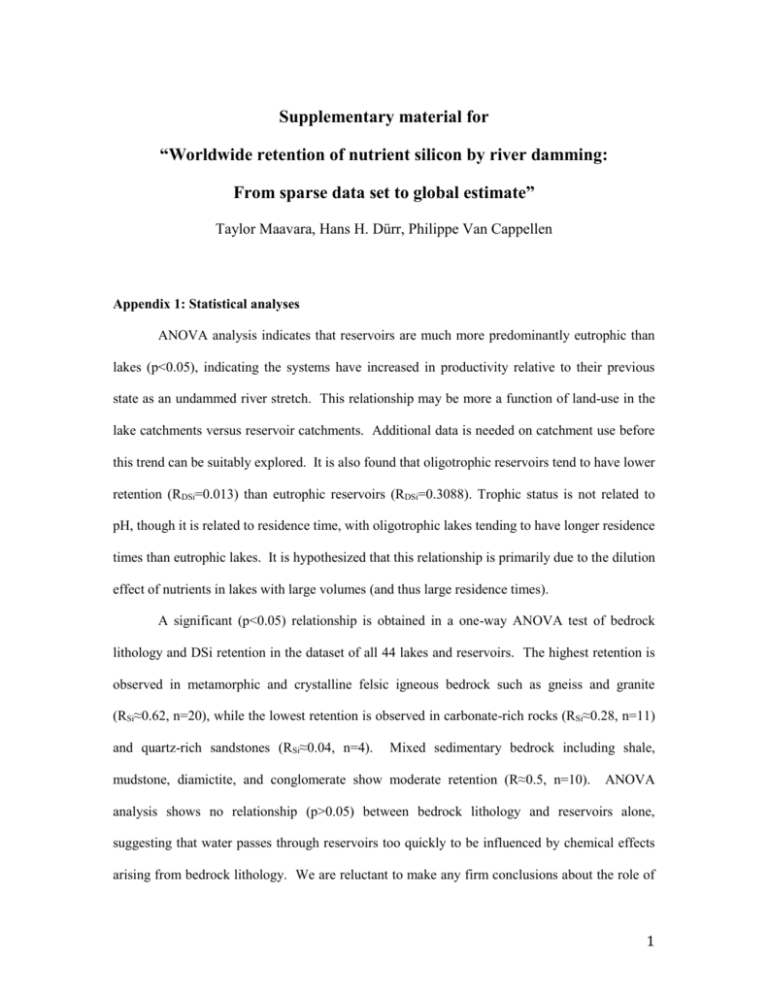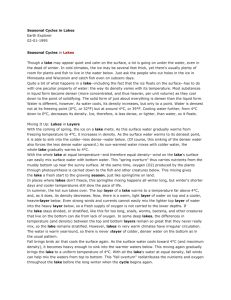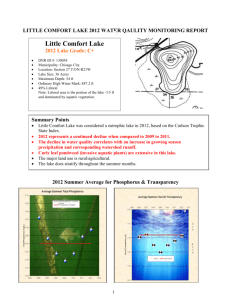Maavara_et_al_GBC_Sup_Mat
advertisement

Supplementary material for “Worldwide retention of nutrient silicon by river damming: From sparse data set to global estimate” Taylor Maavara, Hans H. Dürr, Philippe Van Cappellen Appendix 1: Statistical analyses ANOVA analysis indicates that reservoirs are much more predominantly eutrophic than lakes (p<0.05), indicating the systems have increased in productivity relative to their previous state as an undammed river stretch. This relationship may be more a function of land-use in the lake catchments versus reservoir catchments. Additional data is needed on catchment use before this trend can be suitably explored. It is also found that oligotrophic reservoirs tend to have lower retention (RDSi=0.013) than eutrophic reservoirs (RDSi=0.3088). Trophic status is not related to pH, though it is related to residence time, with oligotrophic lakes tending to have longer residence times than eutrophic lakes. It is hypothesized that this relationship is primarily due to the dilution effect of nutrients in lakes with large volumes (and thus large residence times). A significant (p<0.05) relationship is obtained in a one-way ANOVA test of bedrock lithology and DSi retention in the dataset of all 44 lakes and reservoirs. The highest retention is observed in metamorphic and crystalline felsic igneous bedrock such as gneiss and granite (RSi≈0.62, n=20), while the lowest retention is observed in carbonate-rich rocks (RSi≈0.28, n=11) and quartz-rich sandstones (RSi≈0.04, n=4). Mixed sedimentary bedrock including shale, mudstone, diamictite, and conglomerate show moderate retention (R≈0.5, n=10). ANOVA analysis shows no relationship (p>0.05) between bedrock lithology and reservoirs alone, suggesting that water passes through reservoirs too quickly to be influenced by chemical effects arising from bedrock lithology. We are reluctant to make any firm conclusions about the role of 1 bedrock lithology on RD in lentic systems due to the relatively poor distribution of lithologies present in the dataset compared with the global distribution (Figure 1). Not surprisingly, a significant relationship is also found between bedrock lithology and pH, with carbonate and sandstone bedrocks tending towards alkaline and metamorphic and granitic rocks tending towards acidic. Climate, represented by precipitation and temperature, does not seem to play much of a role in influencing retention, though there may be some relationship between R DSi and annual temperature, as indicated by the results of a linear regression model (p<0.05). However, bedrock lithology and temperature and precipitation are not statistically independent of each other, suggesting the climate relationship may be a relic of the geological effect. The relationship between reservoir age and retention remains unclear due to the uncertainty regarding the regularity and extent of sediment dredging in individual reservoirs. However, a weak trend may be present indicating decreasing DSi retention with reservoir age, suggesting dissolution of deposited sediments into solution is occurring, allowing for the export of DSi. This relationship emerges more clearly in the mechanistic model and is discussed in more detail in the main text, section 4.3. Regression models indicate exponential decay trends relating RD to reservoir volume and depth. Statistically significant R2 values do not exceed 0.3 for any of these relationships (the best fit being depth) (Table S2). Instead, the statistical analyses indicate that RD is most closely related to the water residence time (τr). Retention of DSi in lakes exhibits an exponential growth to a maximum with the water residence time (Figure S3a), given by: 𝑅𝐷 = 0.7679 × (1 − 𝑒 −1.1210𝜏𝑟 ); R2 = 0.61, p<0.05, n=24 (1) 2 where τr is expressed in units of years. The reservoirs in the calibration data set not only tend to have shorter water residence times than the lakes, they also follow a distinctly separate trend with respect to τr. The following lognormal relationship (Figure S3b) is obtained for all reservoirs: 𝑅𝐷 = 2 𝜏 ln( 𝑟⁄0.5507) 0.2219 exp [−0.5 ( 0.6573 ) ]; 𝜏𝑟 R2 = 0.8154, p<0.0001, n=18 (2) The robustness of Equation (2) was tested by performing 10 rounds of cross-validation with randomly generated training sets of 70% of the data and using the remaining 30% for validation. The average standard error for the lognormal fits was over five times lower than for a linear regression model (0.30 versus 1.60), hence supporting the log-normal distribution. It is unclear as to whether the shape represented by equation (2) is a “true” process-justified relationship in reservoirs. While some argument can be made justifying the peaks and valleys in the curve arising as a result of different rates of dissolution, sedimentation and export in each reservoir (which can be reproduced to some degree using the mechanistic model), we chose not to pursue this relationship in the global estimate. 3 Table S1: Summary data for lakes used to calibrate retention model. References: (1) Welch et al. [1986]; (2) Likens [1985]; (3) Hongve [1994]; (4) Kopacek et al. [2006]; (5) Cornwell et al. [1992]; (6) Jonasson et al. [1974]; (7) Barbieri et al. [1992]; (8) Hofmann et al. [2002]; (9) Lazzaretti-Ulmer et al. [1999]; (10) Lafrancois et al. [2009]; (11) Triplett et al. [2012]; (12) Triplett et al. [2008]; (13) Garibaldi et al. [1999]; (14) Arai et al. [2012]; (15) Goto et al. [2007]; (16) Jens Hartmann – personal communication; (17) Conley et al. [1993]; (18) Weyhenmeyer [2004]; (19) Muvundja [2009]; (20) Schelske [1985]; (21) Hecky et al. [1996]; (22) Müller et al. [2005]; (23) Langenberg et al. [2003]. Latitude 60.15 48.78 Lake/reservoir name Jade Far Spring P&N Mirror Rawson (Lake 239) Nordbytjernet Plesne Lake 68.6 56 46 Toolik Lake Lake Esrum Lake Lugano 44.9 44.4 45.43 36 35.2 St. Croix Pepin Lake Iseo Lake Kasumigaura Lake Biwa 59.5 58.5 -2 44 47.3 Malaren Vattern Kivu Michigan Superior Sweden Sweden Africa USA Canada -12.2 53 Malawi Baikal Africa Russia -6.3 Tanganyika Africa 63.6 63.6 63.6 63.6 43.6 49.65 Location Bedrock lithology Surface area (km2) 0.036 0.037 0.069 0.071 0.15 0.56 Mean depth (m) 1.82 3.61 2.71 3.28 5.75 10.18 pH Climate Gneiss, carbonate Gneiss, carbonate Gneiss, carbonate Gneiss, carbonate Mixed metamorphic Plutonic (felsic) Trophic status Oligo Oligo Oligo Oligo Oligo Eu Canada Canada Canada Canada USA Canada RSi Reference Arctic Arctic Arctic Arctic Temperate Temperate Residence time (years) 0.85 2.93 1.63 2.9 1.02 10.8 5.90 6.15 6.20 6.40 6.36 4.92 0.92 0.80 0.57 0.73 0.65 0.44 1 1 1 1 2 2 Norway Czech Republic Alaska Denmark Switzerland/It aly USA USA Italy Japan Mixed metamorphic Mixed metamorphic Oligo Meso 0.28 0.75 9.9 0.82 7.60 5.00 Subarctic Temperate 1.4 0.8 0.45 0.24 3 4 Mixed sedimentary Mixed sedimentary Gneiss, carbonate Oligo Eu Eu 1.5 17.3 27.5 7 12.3 171 6.80 8.30 7.60 Arctic Subarctic Temperate 1 9.6 12 0.17 0.65 0.785 5 6 7, 8, 9 Sandstone Sandstone Carbonate Mixed sedimentary Meso Eu Eu Eu 35 103 61 168 14 8.9 123 4 7.82 8.10 7.70 8.14 Temperate Temperate Temperate Subtropical 0.1 0.05 4.2 0.57 0.038 -0.11 0.84 0.56 10, 11, 12 10,11, 12 13 14 Japan Mixed igneous, carbonate Plutonic (felsic) Plutonic (felsic) Mixed metamorphic Mixed sedimentary Mixed igneous, metamorphic Mixed metamorphic Mixed igneous, carbonate Mixed metamorphic Meso 670 41 7.90 Subtropical 5 0.8 15, 16 Meso Oligo Oligo Meso Oligo 1140 1900 2700 5800 82367 13 40 245 84 148 7.53 7.60 9.00 8.40 7.35 Subarctic Subarctic Tropical Temperate Subarctic 3 58 100 100 191 0.83 0.94 0.53 0.80 0.7 17, 18 17, 18 19 20 20 Meso Oligo 29600 31475 292 740 7.90 7.10 Tropical Arctic 140 330 0.96 0.76 21 22 Oligo 32900 570 8.40 Tropical 440 0.98 23 4 Table S2: Summary statistics of variables used in calibration dataset. Note that hydraulic load is calculated as Discharge/Surface area. Dataset Independent variable Lakes and reservoirs Lake vs reservoir Dependent variable RD Water residence time Hydraulic load Trophic status Bedrock lithology Climate pH RD pH RD pH Water residence time Climate RD RD Bedrock lithology Trophic status pH RD RD RD Climate Water residence time RD RD Volume RD Hydraulic load RD Depth RD Reservoir age RD Trophic status Reservoirs only Test Independent samples t-test Independent samples t-test Independent samples t-test Independent samples t-test 1-way ANOVA 1-way ANOVA 1-way ANOVA 1-way ANOVA 1-way ANOVA 1-way ANOVA 1-way ANOVA Linear regression 1-way ANOVA 1-way ANOVA Linear regression 1-way ANOVA Non-linear regression Non-linear regression Linear regression Non-linear regression Linear regression p-value, R2 (if applicable) 7.172 x 10-6 Significant? 0.01947 Yes 0.02336 Yes 0.02547 Yes 0.00814 0.0655 0.143 0.162 0.0347 Yes No No No Yes 0.005 0.0227 p=0.608, R2=0.006314 0.788 0.0913 p=0.234, R2=0.07769 0.171 p<0.0001, R2=0.8154 p<0.0001, R2=0.16124 p<0.0001, R2 = 0.2846 R2 = 0.2729, p<0.0001 0.7071 Yes Yes No Yes No Yes No No Yes No No No No 5 Table S3: Responses of RD and RR to doubling and halving of parameters in mechanistic model in local sensitivity analysis. Default parameters are listed in section 5.3. Default RD = 0.056 and RR = 0.086. Percent change calculated as (default retention – sensitivity retention)/(default retention), and so negative values indicate an increase in retention compared with the default. Parameter Parameter description k23 Decay siliceous biomass rate constant (yr-1) PSi ageing plus sedimentation rate constant (yr-1) Biological DSi uptake (halfsaturation constant) (mol m-2) Fresh PSi dissolution rate constant (yr-1) Dissolution deposited SSi rate constant (yr-1) Permanent burial SSi rate constant (yr-1) Biological DSi uptake maximum rate constant (mol m-2 yr-1) PSi influx (mol yr-1) k34 Ks k31 k41 k4,buried Rmax Fin,3 % change from default RD (doubling, halving) 0.02, -0.03 % change from default RR (doubling, halving) 0.01, -0.02 -14.0, 14.6 -30.7, 32.0 0.16, -0.09 0.06, -0.03 38.2, -24.0 13.7, -8.6 15.5, -8.3 9.2, -4.9 -0.16, 0.08 -0.10, 0.05 -137.9, 68.5 -49.6, 24.6 37.0, -18.5 54.8, -27.4 6 Figure S1: Monte Carlo output for RSi retention plotting as a function of residence time. Most relevant statistically significant (p<0.05) regression analyses trend lines are shown. R2 values for power law, linear, quadratic, exponential growth and cubic curves are 0.31, 0.11, 0.24, 0.04 and 0.27, respectively. Because our focus in the manuscript is RSi retention, we therefore apply a power law relationship to DSi retention for consistency. 7 Figure S2: Monte Carlo output for DSi retention. Solid lines are median, dashed lines are means for each box. The edges of each box represent the 1st and 3rd quartiles, and the whiskers are standard deviations. Retentions of 1 at lower residence times arise primarily in small reservoirs (i.e. low volume, low surface area) with extremely high productivity (i.e. up to an order of magnitude higher Rmax than that calculated using equation 4). 8 Figure S3: a) Lake and b) reservoir DSi retentions predicted using equations 1 and 2, respectively. Dashed lines indicated 95% confidence intervals. 9 Additional references Arai, H. and Fukushima, T. (2012). Silicon budget of eutrophic Lake Kasumigaura, Japan. Journal of Soils and Sediments 12: 1501-1507. Barbieri, A. and Mosello, R. (1992). Chemistry and trophic evolution of Lake Lugano in relation to nutrient budget. Aquatic sciences 54 (3): 219-237. Conley, D.J. Stalnacke, P., Pitkanen, H., and Wilander, A. (2000). The transport and retention of dissolved silicate by rivers in Sweden and Finland. Limnology and Oceanography 45: 1850-1853. Cornwell, J.C., and Banahan, S. (1992). A silicon budget for an Alaskan arctic lake. Hydrobiologia 240: 37-44. Garibaldi, L., Mezzanotte, V., Brizzio, M.C., Rogora, M. and Mosello, R. (1999). The trophic evolution of Lake Iseo as related to its holomixis. Journal of Limnology 58 (1): 10-19. Goto, N., Iwata, T., Akatsuka, T., Ishikawa, M., Kihira, M., Azumi, H., Anbutsu, K., and Mitamura, O. (2007). Environmental factors which influence the sink of silica in the limnetic system of the large monomictic Lake Biwa and its watershed in Japan. Biogeochemistry 84: 285-295. Hecky, R.E., Bootsma, H.A., Mugidde, R., and Bugenyi, F.W.B. (1996). Phosphorus pumps, nitrogen sinks, silicon drains: Plumbing nutrients in the African Great Lakes. In The Limnology, Climatology, and Paleoclimatology of the East African lakes, edited by T.C. Johnson and E.O. Odada, pp. 205-224, Gordon and Breach, Amsterdam. Hofmann, A., Roussy, D., and Filella, M. (2002). Dissolved silica budget in the North basin of Lake Lugano. Chemical Lithology 182: 35-55. Hongve, D. (1994). Nutrient metabolism (C, N, P, and Si) in the trophogenic zone of a meromictic lake. Hydrobiologia 277: 17-39. Jónasson, P.M., Lastein, E., and Rebsdorf, A. (1974). Production, insolation, and nutrient budget of eutrophic Lake Esrom. Oikos 25 (3): 255-277. Kopáček, J., Turek, J., Hejzlar, J., Kaňa, and Porcal, P. (2006). Element fluxes in watershed-lake ecosystems recovering from acidification: Plešné Lake, the Bohemian Forest, 2001-2005. Biologia, Bratislava 61/Suppl. 20: S427-S440. Lafrancois, B.R., Magdalene, S., and Johnson, D.K. (2009). Recent water quality trends and a comparison to sediment-core records for two riverine lakes of the Upper Mississippi River basin: Lake St. Croix and Lake Pepin. Journal of Paleolimnology 41: 603-622. Langenberg, V.T., Nyamushahu, S., Roijackers, R. and Koelmans, A.A. (2003). External nutrient sources for Lake Tanganyika. Journal of Great Lakes Research 29 (Supp. 2): 169-180. Lazzaretti-Ulmer, M.A., Hanselmann, K.W. (1999). Seasonal variation of the microbially regulated buggering capacity at sediment-water interfaces in a freshwater lake. Aquatic sciences 61: 59-74. Likens, G.E. (1985). The lake ecosystem, in An Ecosystem Approach to Aquatic Ecology: Mirror Lake and its Environment, edited by G.E. Likens, pp. 337-344, Springer, New York. Müller, B., Maerki, M., Schmid, M., Vologina, E.G., Wehrli, B., Wüest, A., and Sturm, 10 M. (2005). Internal carbon and nutrient cycling in Lake Baikal: sedimentation, upwelling, and early diagenesis. Global and Planetary Change (46): 101-124. Muvundja, F.A., Pasche, N., Bugenyi, F.W.B., Isumbisho, M., Muller, B., Namugize, J.N., Rinta, P., Schmid, M., Stierli, R. and Wuest, A. (2009). Balancing nutrient inputs to Lake Kivu. Journal of Great Lakes Research 35: 406-418. Schelske, C.L. (1985). Biogeochemical silica mass balances in Lake Michigan and Lake Superior. Biogeochemistry 1: 197-218. Triplett, L.D., Engstrom, D.R., and Conley, D.J., and Schellhaass, S.M. (2008). Silica fluxes and trapping in two contrasting natural impoundments of the upper Mississippi River. Biogeochemistry 87: 217-230. Welch, H.E. and Legault, J.A. (1986). Precipitation chemistry and chemical limnology of fertilized and natural lakes at Saqvaqjuac, NWT. Canadian Journal of Fisheries and Aquatic Sciences 43: 1104-1134. Weyhenmeyer, G.A. (2004). Synchrony in relationships between the North Atlantic Oscillation and water chemistry among Sweden’s largest lakes. Limnology and Oceanography 49 (4): 1191-1201. 11









